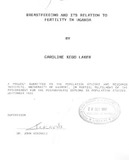| dc.description.abstract | This study was undertaken to examine how breastfeeding relates to fertility in Uganda.
The objective was based on the fact that family planning programs were introduced to Uganda almost two decades ago. However to date the program oeemc to have had no major impact. Hence there is a need to re-examine what other avenues are available to tackle this problem. Breastfeeding can provide such an alternative.
Data from the Uganda Demographic Health Survey chows that a majority of Uganda women breastfeed their babies for an average of 19 months. Prolonged durations of breastfeeding after successive livebirthc 1c one of traditional mechanicm used though not deliberately to keep fertility well below its biological maximum.
This study examines the relationship between breastfeeding ana postpartum amenorrhea. This is because the duration of postpartum amenorrhea following child birth has been observed to increase with increased duration of breastfeeding. The extent to which fertility is reduced during the period prior to the resumption of menstruation is therefore determined by the extent of breastfeeding. Thus the duration of postpartum amenorrhea is here ucod as an index of lactational Infertility.
Using the characteristics of 2921 women in the last closed birth Interval differentials in breastfeeding and postpartum amenorrhea were studied. Large differentials were observed among the selected socio-economic and demographic variables.
The study employed cross tabulation and Borga3rts analytical
and empirical framework 3s tools of analysis. It was shown tnat women with longer durations of breastfeeding have longer durations of amenorrhea and longer birth intervale. With long amcnorrheic periodG women are able to attain birth intervals of 3 years in the absence of contraceptive use.
The effect of urbanisation, maternal education and workotatuc was negatively related to long durations of breastfeeding and amenorrhea.
Similarly increace in ago and parity did seem to have a positive effect on breastfeeding and amenorrhea. However, contraceptive use was found to be inversely related to long breastfeeding and amonorrhelc durations. Strategics to promote breastfeeding included breastfeeding educational programs, availability of labour laws promoting maternity leave and benefits, tho integration of breastfeeding programs into existing family planning programs and training of personnel in breastfeeding management programs. | |

